South Front
25 Apr 2024 | 11:18 am
1. U.S. Secretly Shipped 100 ATACMS Tactical Ballistic Missiles To Ukraine
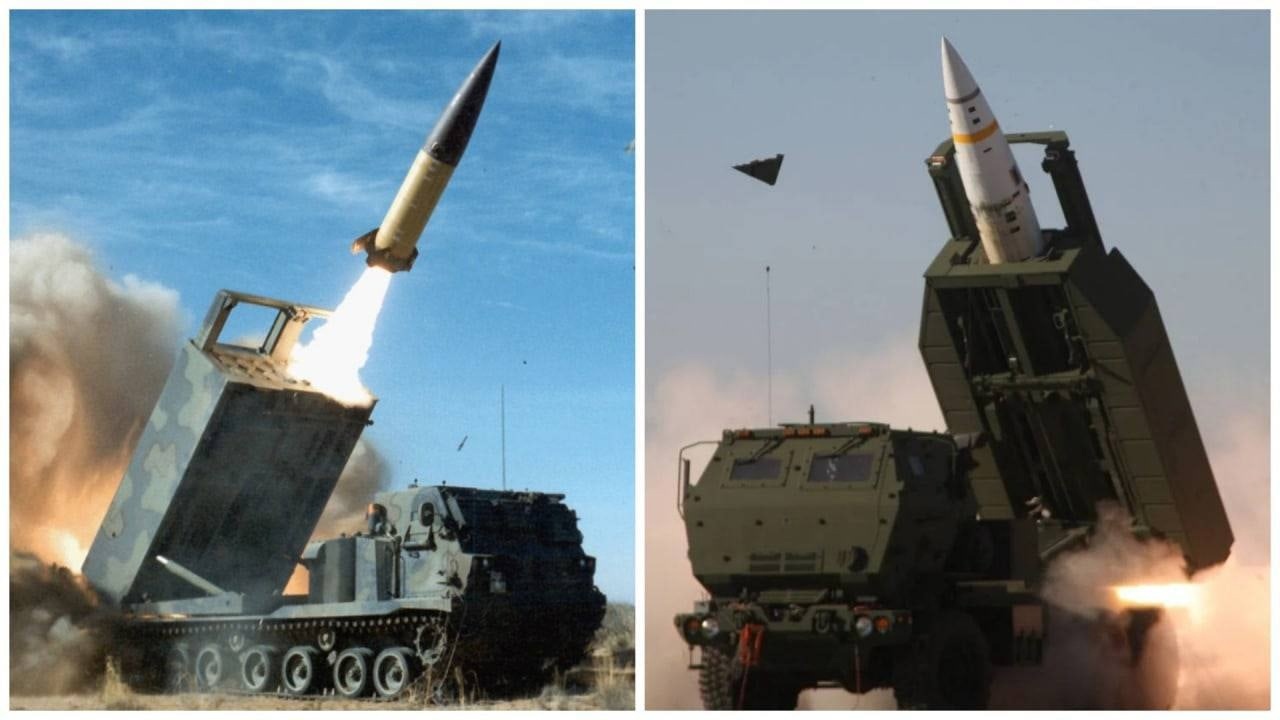
File image.
The United States delivered "long-range" ATACMS tactical ballistic missiles to Ukraine earlier this month following a directive from President Joe Biden, the Pentagon announced on April 24.
The MGM-140 is a tactical ballistic missile that can be fired from the tracked M270 Multiple Launch Rocket System (MLRS) and the wheeled M142 High Mobility Artillery Rocket System (HIMARS), both are already in service with Kiev forces.
President Biden secretly approved the transfer of the missiles in February for use inside Ukrainian territory, Pentagon spokesman Lieutenant Colonel Garron Garn said, adding that the missiles were then quietly included in the $300 million aid package announced on March 12 and ultimately delivered to Ukraine earlier this month.
"It was not announced that we are providing Ukraine with this new capability at the time in order to maintain operational security for Ukraine at their request," Garn said.
In October 2023, a year and eight months after the start of the Russian special military operation in Ukraine, Kiev forces received a limited number of ATACMS missiles from the U.S. However, the missiles were of the older M39 Block I verison, which has a range of 165 kilometers. This version is armed with a cluster warhead with 950 M74 bomblets.
Kiev forces quickly used the missiles to target Berdiansk Airport as well as several gatherings and ammunition dumps of the Russian military in the special military operation zone. Some of the missiles were intercepted and the damage caused by the strikes was very limited.
The Pentagon didn't clarify what "long-range" version of the ATACMS was shipped to Ukraine. The U.S. might have supplied the M39A1 Block I which is armed with a cluster warhead with 300 M74 bomblets but has a range of 300 kilometers, or with the M48 QRU and M57 Block IA Unitary versions which are both armed with WAU-23/B unitary warheads and have a range of 270 and 300 kilometers respectively.
Biden reportedly directed his team to take this step following Russia's alleged procurement and use of North Korean ballistic missiles against Ukraine, and recent Russian strikes on infrastructure in Ukraine.
"We had warned Russia against acquiring North Korean ballistic missiles and against renewing its attacks against Ukraine's civilian infrastructure," Pentagon spokesman Major Dietz said. "With our readiness concerns resolved, we were able to follow through on our warning and provide this long-range capability to Ukraine."
More ATACMS missiles are expected to be included in the new military assistance package the Pentagon announced on April 24 after Biden signed into law an aid package providing nearly $61 billion in assistance for Ukraine following months of delays in Congress.
The New York Times reported on April 25 that the missiles recently supplied by the U.S. were used in the April 17 Ukrainian attack on Dzhankoy airfield in the Crimean Peninsula.
Kiev forces could use long-range ATACMS missiles to attack targets in the Crimean Peninsula, or deeper in Russian territory. The Russian military has means to intercept the missiles, like the S-300V4 and S-400 air defense system. Still, such attacks would be a major escalation and Moscow could hold Washington responsible.
_______________________________________________________________________________________________________________________
SouthFront: Analysis and Intelligence
NOW hosted at southfront.press
Previously, SouthFront: Analysis and Intelligence was at southfront.org.
The .org domain name had been blocked by the US (NATO) (https://southfront.press/southfront-org-blocked-by-u-s-controlled-global-internet-supervisor/) globally, outlawed and without any explanation
Back before that, from 2013 to 2015, SouthFront: Analysis and Intelligence was at southfront.com
- Russian Army Captures U.S.-Made Assault Breacher Vehicle Near Avdeevka (Video, Photos)
- In Video: Russian Lancet Loitering Munition Hit German-Made MARS II Rocket Launcher In Ukraine
The post U.S. Secretly Shipped 100 ATACMS Tactical Ballistic Missiles To Ukraine appeared first on South Front.
25 Apr 2024 | 10:09 am
2. Blinded By Love, Israeli Military Driver Sent Information On Iron Dome Systems To Iran
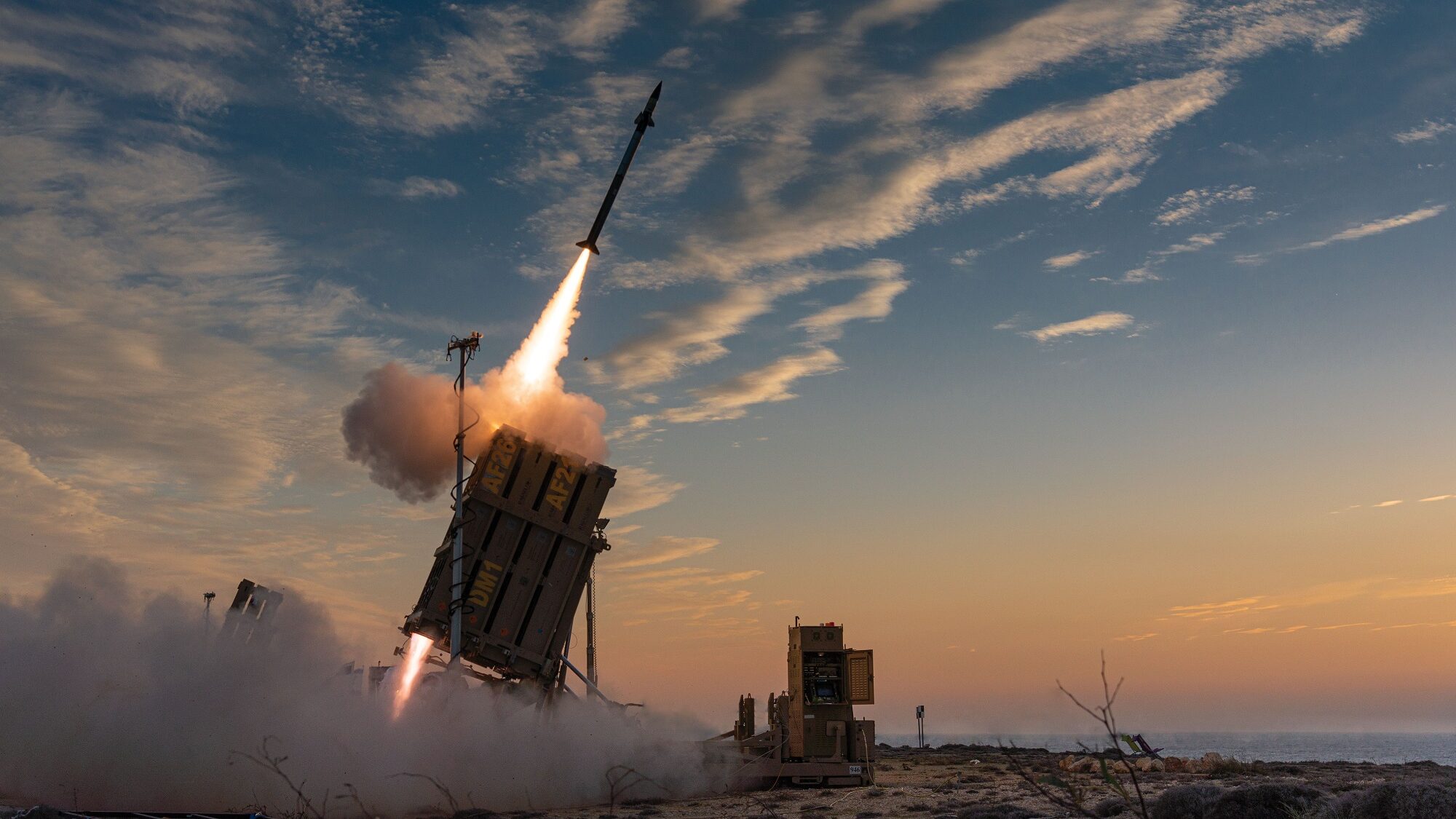
Iron Dome in action, on May 13, 2021. (Avichai Socher/Israeli Defense Forces)
A truck driver working for the Israeli Defense Forces (IDF) took photos of Iron Dome air defense batteries and sent them to an Iranian-run account on Facebook, Hebrew media reported on April 25.
The Israeli Public Broadcasting Corporation, known as Kan in Hebrew, said that the driver took dozens of photos of Iron Dome batteries while on duty and sent the footage to an account he believed belonged to a woman he was in love with.
The driver "voluntarily" documented the Iron Dome batteries with their locations and sent them to the supposed woman, only to later discover that the account was fake and that the information was handed over to an Iranian side, the broadcaster added.
The Iron Dome was developed by Rafael Advanced Defense Systems and Israel Aerospace Industries mainly to intercept and destroy short-range rockets and shells. However, the system can also engage more traditional aerial targets, like fighter jets, helicopters, drones and cruise missiles. The system has a maximum range of 70 kilometers.
Israel claims that the Iron Dome system has a success rate of around 90%. Nevertheless, the system's effectiveness has been questioned on numerous occasions since it first entered service with the IDF in 2011.
During the ongoing war in the Gaza Strip, the system failed to intercept thousands of projectiles, including rockets and drones, which were launched at southern Israel by the Hamas Movement and other Palestinian armed factions. It also failed to repel several rocket and drone attacks launched at the northern part of the country by Hezbollah from Lebanon.
Iranian cyber operations against Israel have been on the rise for quite some time now. In the last few years, Israeli intelligence and security forces unveiled several Iranian cyber operations which were meant to collect intelligence and even recruit spies.
_______________________________________________________________________________________________________________________
SouthFront: Analysis and Intelligence
NOW hosted at southfront.press
Previously, SouthFront: Analysis and Intelligence was at southfront.org.
The .org domain name had been blocked by the US (NATO) (https://southfront.press/southfront-org-blocked-by-u-s-controlled-global-internet-supervisor/) globally, outlawed and without any explanation
Back before that, from 2013 to 2015, SouthFront: Analysis and Intelligence was at southfront.com
- In Video: Hezbollah Knocks Out Israeli Merkava Tank
- Yemen's Houthis Announce Attacks On Three American, Israeli Vessels
The post Blinded By Love, Israeli Military Driver Sent Information On Iron Dome Systems To Iran appeared first on South Front.
25 Apr 2024 | 9:24 am
3. In Video: Hezbollah Knocks Out Israeli Merkava Tank
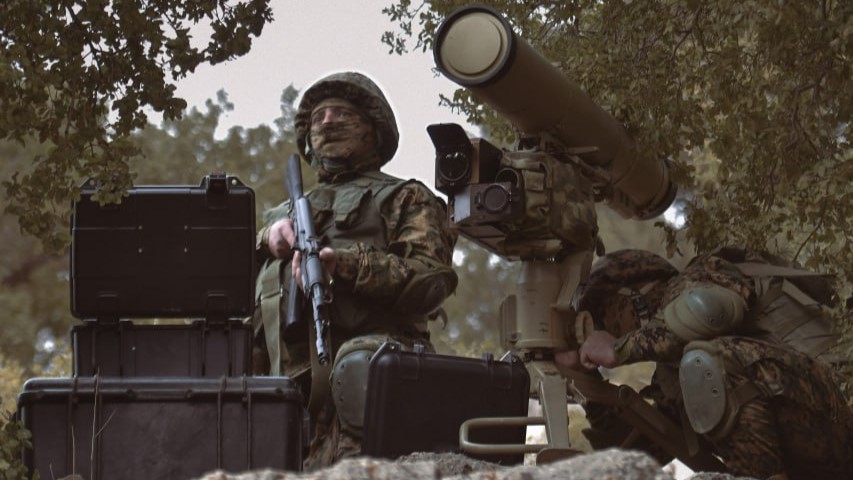
Illustrative image.
Hezbollah's Military Media released on April 24 video footage showing a successful strike against a Merkava Mk 4M main battle tank of the Israeli Defense Forces (IDF).
The tank was targeted with an anti-tank guided missile (ATGM) -most likely a Russian-made 9M133 Kornet or the Iranian copy known as Dehlavieh- while it was moving into a firing position near the Metula military site on the Lebanese-Israeli border on April 17 at night.
The missile fired by Hezbollah hit the tank, knocking it to the side of the road. The IDF made an attempt to recover the tank under the cover of a smoke screen. However, its efforts were unsuccessful and the damaged tank was abandoned.
The Merkava Mk 4M is one of the IDF's most advanced pieces of equipment. The tank is equipped with the Trophy active protection system.
Still, Hezbollah has managed to destroy or damage several tanks of this type since the outbreak of the clashes on the Lebanese-Israeli border on the backdrop of the IDF attack on the Palestinian Gaza Strip. The group mainly used laser-guided Kornet and Dehlavieh ATGMs as well as the Iranian-made Almas missile system, a copy of Israel's Spike ATGM with electro-optical guidance and a top-attack capability.
It's worth noting that Hezbollah's Military Media also released two other videos on April 24 and 25 showing recent rocket and missile attacks on the Israeli settlements of Shomera, Margaliot, Avivim and the base of Ein Zeitim.
The clashes on the Lebanese-Israeli border have so far resulted in eight civilian deaths on the Israeli side, as well as the deaths of at least 11 IDF soldiers and reservists. On the Lebanese side, more than 400 people have been killed, including 269 fighters of Hezbollah and at least 70 civilians.
_______________________________________________________________________________________________________________________
SouthFront: Analysis and Intelligence
NOW hosted at southfront.press
Previously, SouthFront: Analysis and Intelligence was at southfront.org.
The .org domain name had been blocked by the US (NATO) (https://southfront.press/southfront-org-blocked-by-u-s-controlled-global-internet-supervisor/) globally, outlawed and without any explanation
Back before that, from 2013 to 2015, SouthFront: Analysis and Intelligence was at southfront.com
- Israel Strikes Back Against Iran
- Israeli Army Escalates Against Hezbollah, Attacks Dozens Of Targets In Southern Lebanon (Video)
The post In Video: Hezbollah Knocks Out Israeli Merkava Tank appeared first on South Front.
25 Apr 2024 | 8:48 am
4. Yemen’s Houthis Announce Attacks On Three American, Israeli Vessels
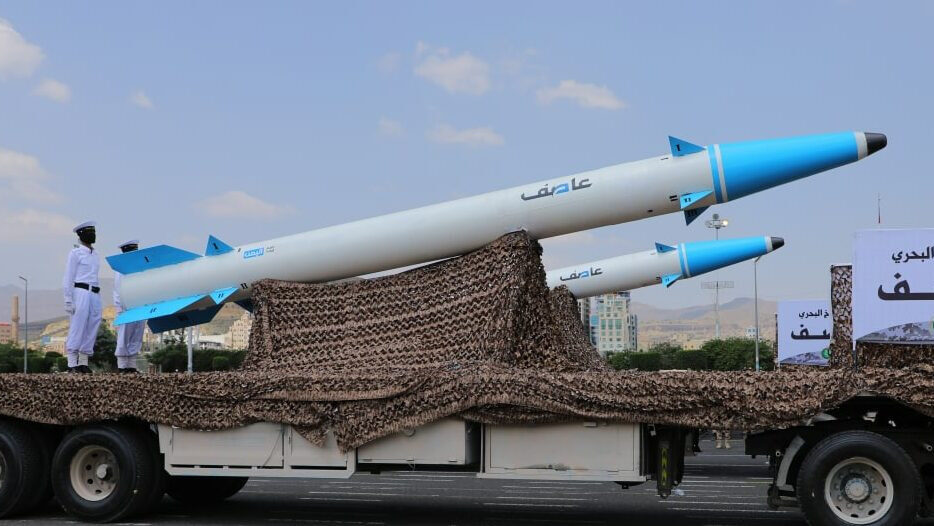
Illustrative image.
The Houthis (Ansar Allah) in Yemen announced on April 24 that they had targeted two United States ships in the Gulf of Aden and an Israeli ship in the Indian Ocean.
"In support of the Palestinian people in Gaza, and in response to the American-British aggression against our country , our naval forces carried out a military operation targeting the American ship MAERSK YORKTOWN in the Gulf of Aden, with a number of suitable naval missiles, and the hit was accurate," Houthi military spokesman Brigade General Yahya Sarea said in a statement.
"We also carried out other two military operations using bomb-laden drones, one of which targeted an American warship in the Gulf of Aden, with a number of drones, and the other operation targeted the Israeli ship MSC VERACRUZ in the Indian Ocean with a number of drones. Both operations achieved their goals successfully," he added without specifying the date of those attacks.
The spokesman went on to warn that the Houthis "will continue to prevent Israeli ships or any ship heading to Israel from transiting the Red Sea, Arabian Sea, and the Indian Ocean until the Israeli aggression on the Palestinian people in Gaza is stopped and the siege is lifted,", vowing that the group would take more actions in the coming days.
Earlier in the day, the United Kingdom Maritime Trade Operations, a detachment of the Royal Navy, reported an explosion near a ship in the Gulf of Aden, which it said caused no damage or casualties.
The U.S. Central Command (CENTCOM) said on April 25 that an allied vessel successfully engaged one anti-ship ballistic missile that was launched from Houthi-controlled areas in Yemen over the Gulf of Aden a day earlier.
The missile was likely targeting the MV Yorktown, a U.S.-flagged, owned, and operated vessel with 18 U.S. and four Greek crew members, the command said in a statement, adding that there were no injuries or damage reported by U.S., coalition, or commercial ships.
Also in the statement, CENTCOM said that its forces successfully engaged and destroyed four drones over Houthi-controlled areas of Yemen on the same day.
"It was determined that the ASBM [anti-ship ballistic missile] and UAVs [unmanned aerial vehicles] presented an imminent threat to U.S., coalition, and merchant vessels in the region," the command said. "These actions are taken to protect freedom of navigation and make international waters safer and more secure for U.S., coalition, and merchant vessels."
The Houthis, who are backed by Iran, have attacked dozens of vessels affiliated with Israel or owned by the U.S. and the UK in the Red Sea, the Gulf of Aden, the Arabian Sea and the Indian Ocean since last November in response to the Israeli war and siege on Gaza.
In an attempt to deter the Houthis, the U.S. and the UK have carried out more than 400 strikes against Houthi-controlled areas in Yemen since January. At least 37 people were killed and 30 others were wounded in these strikes. Nevertheless, the group remains undeterred.
_______________________________________________________________________________________________________________________
SouthFront: Analysis and Intelligence
NOW hosted at southfront.press
Previously, SouthFront: Analysis and Intelligence was at southfront.org.
The .org domain name had been blocked by the US (NATO) (https://southfront.press/southfront-org-blocked-by-u-s-controlled-global-internet-supervisor/) globally, outlawed and without any explanation
Back before that, from 2013 to 2015, SouthFront: Analysis and Intelligence was at southfront.com
- Royal Navy Reports Blast Near Bab al-Mandab, New Attack By Houthis Suspected
- Houthi Leader Says Group Carried Out 14 Operations In Two Weeks
The post Yemen's Houthis Announce Attacks On Three American, Israeli Vessels appeared first on South Front.
25 Apr 2024 | 8:35 am
5. Russian Army Captures U.S.-Made Assault Breacher Vehicle Near Avdeevka (Video, Photos)
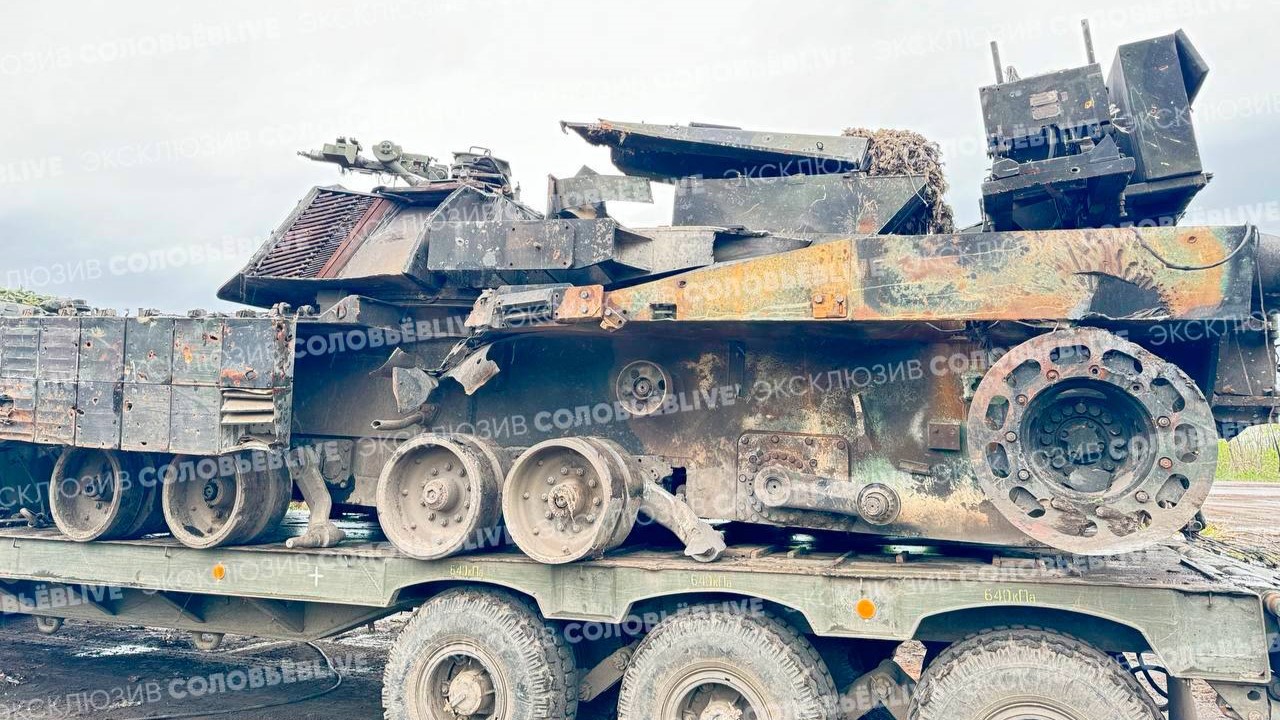
Click to see full-size image. (https://t.me/SolovievLive)
The Russian military has captured an American-made M1150 Assault Breacher Vehicle (ABV) from Kiev forces in the Donetsk direction.
Prominent Russian journalist Vladimir Solovyov published on April 24 Video footage and photos on his Telegram channel showing the damaged engineering vehicle being towed to the rear by a BREM-1 engineering vehicle of the Tsentr Group of Forces.
The vehicle was recovered from an area near the settlement of Berdycha close to the Avdeevka city, according to Solovyov. At least two ABVs were taken out by Russian troops in that direction.
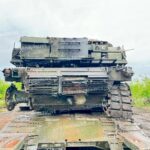
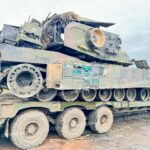
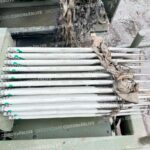
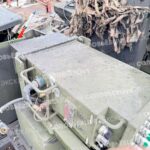
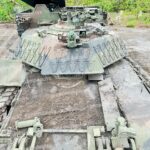

The ABV was designed to clear pathways for troops and other vehicles through minefields and along roadside bombs and improvised explosive devices. The 72-ton, 12-meter vehicle is based on the M1 Abrams main battle tank with a 1,500 horsepower engine, but fitted only with a .50 BMG M2 machine gun and a front-mounted 4.6-meter plow, supported by metallic skis that glide on the dirt.
The vehicle is equipped with the Linear Demolition Charge System, which is made up of rockets carrying C-4 explosives up to 137 meters forward, detonating hidden explosives at a safe distance, so that troops and vehicles can pass through safely.
Last year, Kiev forces received an unknown number of ABVs, reportedly no more than six, from the United States along with some 31 M1A1 SA tanks.
Russia specialists will likely study the captured AVB to better understand its capabilities and weaknesses. After that, the vehicle will likely end up on display at the Kubinka tank museum near the capital, Moscow, or some other military museum in Russia.
_______________________________________________________________________________________________________________________
SouthFront: Analysis and Intelligence
NOW hosted at southfront.press
Previously, SouthFront: Analysis and Intelligence was at southfront.org.
The .org domain name had been blocked by the US (NATO) (https://southfront.press/southfront-org-blocked-by-u-s-controlled-global-internet-supervisor/) globally, outlawed and without any explanation
Back before that, from 2013 to 2015, SouthFront: Analysis and Intelligence was at southfront.com
- In Video: Russian Lancet Loitering Munition Hit German-Made MARS II Rocket Launcher In Ukraine
- UK Entering 'War Footing' Economy
The post Russian Army Captures U.S.-Made Assault Breacher Vehicle Near Avdeevka (Video, Photos) appeared first on South Front.
24 Apr 2024 | 8:05 pm
6. Israel Strikes Back Against Iran
Download video
DEAR FRIENDS. IF YOU LIKE THIS TYPE OF CONTENT, SUPPORT SOUTHFRONT WORK :
MONERO (XMR): 86yfEHs6pkoDEKCxc6MAnQX8cVHmzhYxMVrNuwKgNmqpWK8dDxjgGnK8PtUNJMACbn6xEGxmRauNTHJhUJpg9Mwz8htBBNDBITCOIN (BTC): bc1qgu58lfszcpqu6fd8l98m378wgzugyg9y93lcym
BITCOIN CASH (BCH): qr28d80s5juzv2793k5jrq59xrl5fxd8qg9h3zlkk2
PAYPAL, WESTERN UNION etc: write to info@southfront.press , southfront@list.ru
If you face any problems sending funds to the addresses given above, please contact us: info@southfront.org and southfront@list.ru. Also be aware that many email services such as Hotmail, Yahoo etc. may block correspondence from info@southfront.org and some others put it in spam.
If you want to support SouthFront but have no opportunity to do it via cryptocurrency, please contact us: info@southfront.org and southfront@list.ru.
Israel has launched a bold attack against Iran, however it failed to deter the country or any of its allies in the Middle East.
The attack on April 19 came in response to the April 13-14 Iranian missile and drone strikes on Israel, which was a retaliation to an Israeli strike on the Iranian embassy in the Syrian capital, Damascus, at the beginning of the month.
Iranian media reported the interseption of at least three small drones over Eighth Shekari air base near the city of Isfahan.
In addition to the drones, which were reportedly launched from within Iran, the Israeli military used three never-seen-before air-launched ballistic missiles at the air base. The first stages of the missiles fell in central Iraq.
Israeli strikes hit several air defense sites in southern Syria during the attack, leading to speculation that Israeli warplanes launched their missiles from some area along the country's border with Jordan or Iraq.
The main target of the attack was an air defense site housing one of Iran's S-300PMU2 long-range systems within Eighth Shekari air base. Satellite images showed some burn marks near the fire control radar of the system.
The targeted air defense site is reportedly responsible for the protection of the nearby heavily-fortified Natanz nuclear facility.
Israel didn't acknowledge the attack, neither was officially blamed for it by Iran.
The next day, April 20, an explosion rocked the Kalso military base in the central Iraqi province of Babylon which is used by the Iran-allied Popular Mobilization Forces (PMF). At least one person was killed and eight others were wounded. The U.S. denied responsibility, while some Iraqi sources said that it was the result of an Israeli attack.
In a response to the suspected attack, the Islamic Resistance in Iraq (IRI), which has links to the PMF, struck the southernmost Israeli city of Eilat with a suicide drone late on April 20.
On April 21 and 22 there were two attacks against U.S. bases near the town of Kharab al-Jir in the northeastern Syrian governorate of al-Hasakah and at Ain al-Assad in western Iraqi province of al-Anbar. They were the first attacks against American forces since February. The IRI was blamed.
In Lebanon, Hezbollah also escalated its operations against Israel, shooting down a Hermes-450 combat drone over Lebanon on April 22 and attacking a key base near the northern city of Akko with suicide drones on April 23.
Overall, the Israeli attack has clearly failed to send a strong message to Iran. The results of the attack are questionable, and Tehran allies were not deterred. Now, Israel will likely escalate against the Hamas Movement and other factions in the Gaza Strip to make up for this failure. There are already reports of a U.S. green light for an attack on the heavily-populated city of Rafah in the southernmost part of the Palestinian enclave.
______________________________________________________________________________________________________________________
SouthFront: Analysis and Intelligence
NOW hosted at southfront.press
Previously, SouthFront: Analysis and Intelligence was at southfront.org.
The .org domain name had been blocked by the US (NATO) (https://southfront.press/southfront-org-blocked-by-u-s-controlled-global-internet-supervisor/) globally, outlawed and without any explanation
Back before that, from 2013 to 2015, SouthFront: Analysis and Intelligence was at southfront.com
The post Israel Strikes Back Against Iran appeared first on South Front.
24 Apr 2024 | 7:24 pm
7. Ukrainian Drone Strikes In Russian Rear Regions On April 24, 2024 (Map Update)
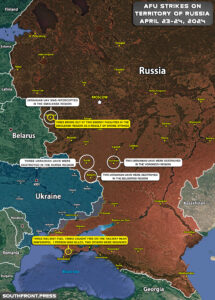
Click to see full-size image
- Three Ukrainian UAVs were destroyed in the Kursk region;
- Two Ukrainian UAVs were destroyed in the Belgorod region;
- Two Ukrainian UAVs were destroyed in the Voronezh region;
- Ukrainian UAV was intercepted in the Smolensk region;
- Three railway fuel tanks caught fire on the railway near Simferopol. 1 person was killed, two others were wounded;
- Fires broke out at two energy facilities in the Smolensk region as a result of drone strikes.
The post Ukrainian Drone Strikes In Russian Rear Regions On April 24, 2024 (Map Update) appeared first on South Front.
24 Apr 2024 | 7:00 pm
8. What Russia’s Deployment Of Long-Range Missiles Means For Scandinavia?
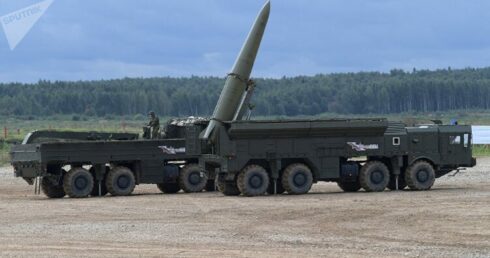
Click to see the full-size image
Written by Drago Bosnic, independent geopolitical and military analyst
In the last couple of years, particularly since the special military operation (SMO) started, the geopolitical landscape of Europe has been marked by NATO-orchestrated tensions that keep escalating. The belligerent alliance's unceasing expansionist tendencies are the main source of instability, especially since it officially extended its warmongering tentacles to Scandinavia, specifically Finland, a country that shares a very long border with Russia. Helsinki's decision to not only join NATO, but also host US military bases left Moscow with no choice except to further reinforce its newly (re)established Leningrad military district that now includes the republics of Karelia and Komi, the regions (oblasts) of Arkhangelsk, Vologda, Kaliningrad, Leningrad, Murmansk, Novgorod and Pskov, as well as the federal city of St. Petersburg and the Yamalo-Nenets autonomous oblast.
Russia has repeatedly expressed concerns that NATO expansion to Finland would mean that assault troops and advanced weapon systems would be deployed within the country, threatening Russia's national security interests. As previously mentioned, Finland has not only refused to reassure its eastern neighbor, but has actually doubled down on the deployment of foreign forces, particularly American. Thus, Moscow was left with no choice but to enhance the security of its second most important city and what has perhaps become one of the premier military districts in the country. This includes the deployment of the now legendary "Iskander-M" missiles precisely in the Leningrad military district. Various missiles of the "Iskander-M" system are known for hypersonic speed (up to Mach 8 while also maneuvering) and a maximum range of approximately 500 km.
In practice, this means that the entire territory of Finland is completely exposed now, the consequence of its suicidal decision to join the world's most aggressive military cartel/racketeering organization. The "Iskander-M's" missiles can use massive 700 kg HE warheads that are excellent against higher concentrations of troops in the rear. Virtually the same goes for much faster 9-A-7660 "Kinzhal" air-launched hypersonic missiles that could also see more active deployment to the Leningrad Military District. According to military sources, Karelia has established a special missile brigade equipped with precisely the "Iskander-M" missile systems. The 14th Army Corps has been transferred to the command of the newly (re)established district and deployed in the Murmansk oblast, which, along with Karelia, is situated along Russia's border with Finland.
"The formation of a missile brigade is a very timely decision. This is an adequate response to Finland's accession to NATO," former commander of the Baltic Fleet, Admiral Vladimir Valuev, told Izvestia.
Valuev also noted that the missile brigade would quickly respond to any threat posed by NATO troops in the area by "carrying out relevant operations". And while Finland is bolstering its ABM (anti-ballistic missile) systems, the "Iskander-M" uses missiles with enhanced countermeasures that have only been improved in the context of the SMO. On the other hand, if Finland were to ever accept or even call for the deployment of American nuclear weapons on its soil, "Iskander-M" is perfectly capable of carrying thermonuclear warheads that Russia would have no other choice but to aim at any strategically important target. Even in the case that the potentially less destructive tactical nuclear weapons are used, this would have disastrous consequences for Helsinki. Obviously, this is not to say the "Iskander-M's" conventional capabilities are any less frightening.
Its missiles have demonstrated remarkable performance in the SMO, obliterating high-value targets with pinpoint accuracy. As previously mentioned, when taking only the 9M723 hypersonic missiles into account, the immediate danger for any larger troop concentrations in Finland lies in its speed and destructive power. On the other hand, this is only one of the two notable versions of the missiles used by the system. The other is the 9M729, essentially a land-based iteration of the "Kalibr" family of cruise missiles. Its range has been a matter of debate for quite some time now, but it could be around 2500 km, meaning that the entire Scandinavia would be covered, including Sweden and Norway. It should be noted that both Helsinki and Stockholm were previously a strategic buffer zone that limited the possibility of a direct Russia-NATO conflict.
However, that's now gone thanks to the belligerent alliance's unrelenting greed for expansionism. Worse yet, it could be argued that Norway has also lost with Sweden's and Finland's accession to NATO, as there are now no directions that Russia couldn't use because of their previous "neutrality". This directly jeopardizes Oslo's southern regions, the most important part of the country. Moscow is also forced to respond in such a way as Norway is directly participating in the militarization of the increasingly contested Arctic region where the United States is trying to establish a firmer presence. Obviously, this is part of the much larger strategy of encircling Russia and placing additional strategic weapons in its proximity, particularly the latest iterations of the B61 thermonuclear bomb. All this is forcing Moscow to make moves it never wanted to, but it's simply left with no other option.
MORE ON THE TOPIC:
- Finland Supports Open War Against Russia
- Finland's Accession To NATO: Russia's Response
- Finland's New 'Defense' Deal With US Eerily Reminds Of Similar One With Nazi Germany
The post What Russia's Deployment Of Long-Range Missiles Means For Scandinavia? appeared first on South Front.
24 Apr 2024 | 5:55 pm
9. Military Situation In Palestine On April 24, 2024 (Map Update)
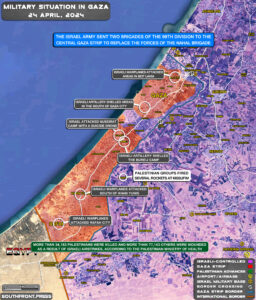
Click to see full-size image
- The Israel Army sent two brigades of the 99th Division to the central Gaza Strip to replace the forces of the Nahal Brigade;
- More than 34,183 Palestinians were killed and more than 77,143 others were wounded as a result of Israeli airstrikes, according to the Palestinian Ministry of Health;
- Israel attacked Nuseirat camp with a suicide drone;
- Israeli warplanes attacked south of Khan Yunis;
- Israeli artillery shelled the Bureij camp;
- Israeli warplanes attacked Rafah city;
- Israeli warplanes attacked areas in Beit Lahia;
- Israeli artillery shelled areas in the south of Gaza city;
- Palestinian groups fired several rockets at Kissufim.
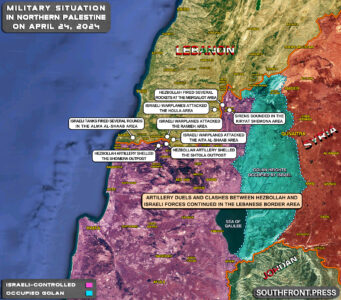
Click to see full-size image
- Hezbollah artillery shelled the Shtola outpost;
- Hezbollah artillery shelled the Shomera outpost;
- Hezbollah fired several rockets at the Mergaliot area;
- Sirens sounded in the Kiryat Shemona area;
- Artillery duels and clashes between Hezbollah and Israeli forces continued in the Lebanese border area;
- Israeli warplanes attacked the Aita al-Shaab area;
- Israeli warplanes attacked the Ramieh area;
- Israeli warplanes attacked the Houla area;
- Israeli tanks fired several rounds in the Alma al-Shaab area.
The post Military Situation In Palestine On April 24, 2024 (Map Update) appeared first on South Front.
24 Apr 2024 | 5:30 pm
10. In Video: Russian Lancet Loitering Munition Hit German-Made MARS II Rocket Launcher In Ukraine
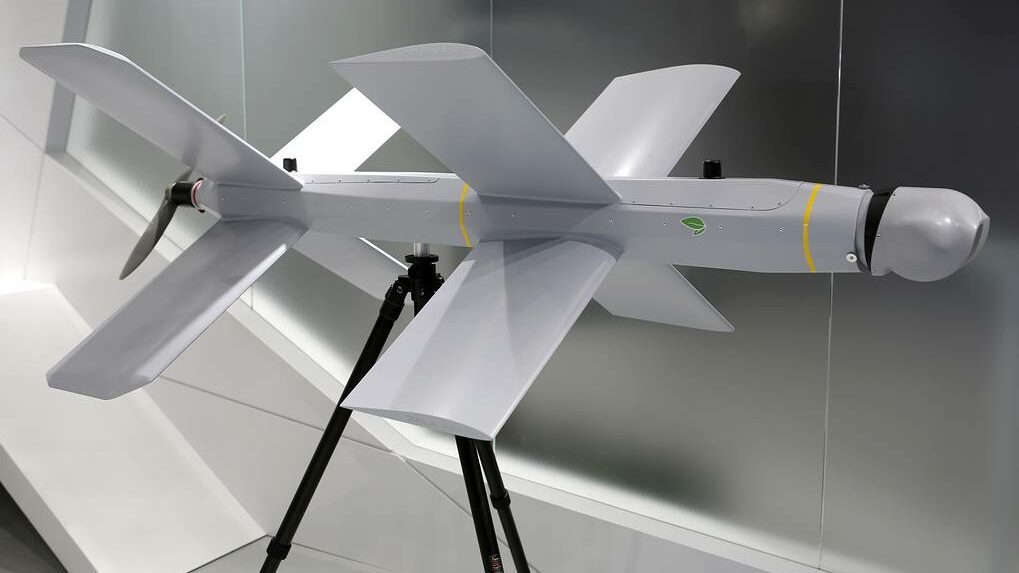
MOSCOW REGION, RUSSIA – JUNE 25, 2019: A ZALA Lancet-3 attack drone developed by Kalashnikov Concern on display at the Army 2019 International Military Technical Forum at Patriot Park. Marina Lystseva/TASS
The Russian military has targeted a German-Made MARS II multiple rocket launcher of Kiev forces using a Lancet loitering munition.
It is unclear when or where exactly the rocket launcher was targeted. Video footage of the strike was first posted on social networks on March 26. At the time, the target was not identified. The video surfaced again on April 23, but this time the target was mentioned. The launcher received a direct hit. However, there were no secondary blasts, possibly because it was not loaded at the time.
The Lancet was developed by the ZALA Aero Group, a subsidiary of Russia's defense giant Kalashnikov Concern. The company produces two versions of the loitering munition, the Izdeliye-52 with an endurance of 30 minutes and a one-kilogram warhead and the larger Izdeliye-51 that has an endurance of around 40 minutes and is armed with a warhead weighting three kilograms.
Both versions are equipped with an elector-optical system and a two-way data-link. This allows them to detect, track and lock on static and moving targets.
The MARS II is the German copy of the American M270 Multiple Launch Rocket System (MLRS) system. The United Kingdom, Norway, France and Germany supplied at least 16 MLRS and MARS II launchers to Kiev forces after the start of the Russian special military operation in Ukraine.
Each MARS II or MLRS launcher can be armed with up to 12 M30/M31 series GMLRS GPS-guided rockets, which have a range of more than 70 kilometers, or two MGM-140 ATACMS tactical ballistic missiles, which have a range from 165 to 300 depending on the version, in two separate pods.
The Russian military has already destroyed or damaged many of Ukraine's MARS II and MLRS systems as well as several of around 40 M142 HIMARS -a lighter, wheeled system that fires the same types of projectiles- which were delivered to Ukraine by the United States over the last two years.
_______________________________________________________________________________________________________________________
SouthFront: Analysis and Intelligence
NOW hosted at southfront.press
Previously, SouthFront: Analysis and Intelligence was at southfront.org.
The .org domain name had been blocked by the US (NATO) (https://southfront.press/southfront-org-blocked-by-u-s-controlled-global-internet-supervisor/) globally, outlawed and without any explanation
Back before that, from 2013 to 2015, SouthFront: Analysis and Intelligence was at southfront.com
- "This Is Your Problem Now": US Leaving Ukraine For Europe To Deal With – French Expert
- Europe Willing To Pursue Proxy War Against Iran Through Israel
The post In Video: Russian Lancet Loitering Munition Hit German-Made MARS II Rocket Launcher In Ukraine appeared first on South Front.



